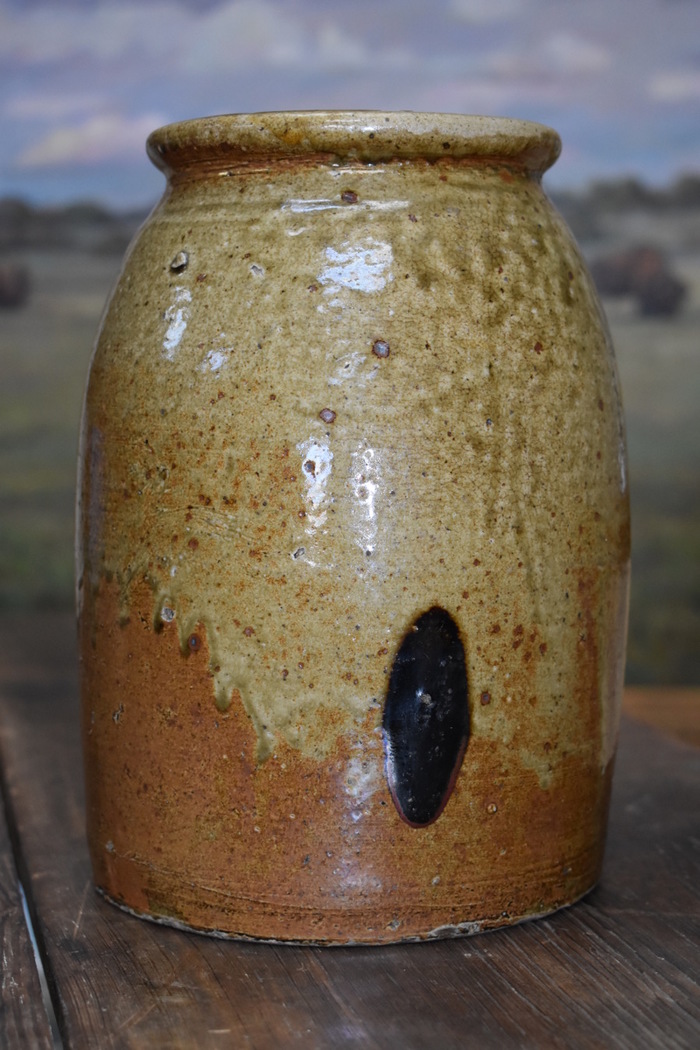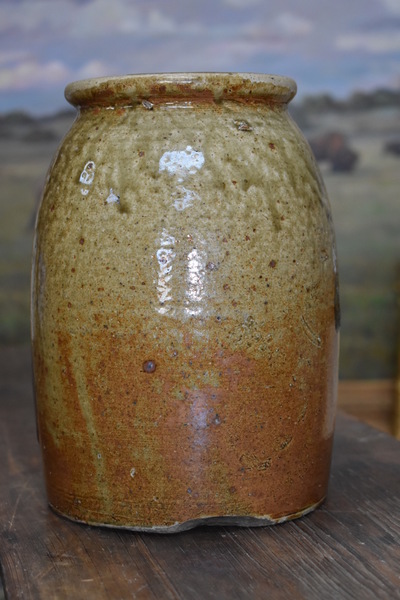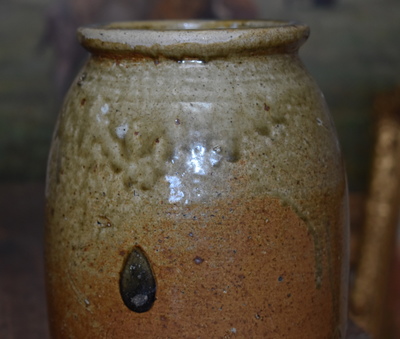1st Site Wilson Pottery Storage Jar
-
- 1st Site Wilson Pottery
- Circa 1860s
- Seguin Texas
- Image Size: 9.25" tall by 6.25" diameter
- Frame Size: Slightly smaller than one gallon
- Medium: Pottery Stoneware
- Circa 1860s
- Storage Jar
- Contact for Price & Info
- View All By This Artist
Details
One of the most beautiful 1st Site Wilson's pieces known. The colors and glaze are spectacular.
Utilitarian Stoneware -
Biography
1st Site Wilson Pottery Circa 1860s
Joey Brackner
WILSON POTTERIES. The vessels made at the Wilson potteries of Guadalupe County represent both the westward extension of Old South cotton culture and the interaction of different cultural groups in mid-nineteenth-century Texas. During the last half of the nineteenth century the three potteries in the community of Capote, near Seguin, supplied a wide area of Central Texas with locally made stoneware necessary for both food storage and preparation. In 1857 John McKamey Wilson, a Presbyterian minister and educator, established the first Wilson pottery, which produced utilitarian alkaline-glazed and salt-glazed stoneware through the Civil War years. Rev. Wilson was not a potter, so the initial pottery operations were probably conducted by his slave potters, Hiram, James, George, and Andrew Wilson. Between 1860 and 1866 a white potter, Marion J. Durham, from Edgefield, South Carolina, and a black potter named John Chandler came to work at the site. Chandler might have been a free man of color or may have belonged to Durham. Durham and Chandler may have influenced the other potters, because most of the pottery found at the earliest Wilson pottery resembles that of the celebrated Edgefield District of South Carolina. The Edgefield District was a center of pottery-making in the South in the early nineteenth century. Many scholars attribute the creation of the southern alkaline-glazed pottery tradition to this period and place. This complex of technologies included the use of an alkaline-based slip glaze, long-tunnel kilns known as "groundhog kilns," and ovoid utilitarian forms sometimes decorated with slip trailing. This southern pottery tradition spread westward with migrating potters, both free and slave, who were largely trained in Edgefield. The pottery contrasted sharply with the salt-glazed stoneware tradition that dominated the border South states northward into the Ohio valley.
The site of the first Wilson pottery near Seguin has most of the characteristics of this southern pottery complex, including green, alkaline-glazed potsherds in a large waste pile and the long, narrow surface indications of a groundhog kiln. However, salt-glazed potsherds also littered the site. The presence of the salt glaze, which was the preferred stoneware glaze from the Mid-Atlantic southern states and states farther north, suggests the presence of a potter from that area. This potter could have been one of the slaves or perhaps Isaac Suttles, an Ohioan who worked with M. J. Durham and Thomas Chandler in 1870, and who could have been present at the first pottery. The wide variety of vessel forms made at this first Wilson site attests to the isolated frontier conditions in Central Texas. Forms such as chamber pots, churns, bowls, pitchers and storage jars were made to satisfy local needs. The Civil War disrupted the lives of all the potters in Capote. After the troops went home and the slaves were freed, the potters at the Wilson potteries relocated to two separate shops in 1869. One was run by M. J. Durham, with John Chandler and Isaac Suttles, and the other was run by the former slaves, Hiram, James, and Andrew Wilson. H. Wilson and Company was one of the rare examples of a pottery owned and operated by a black man in the nineteenth-century South. Its product combined attributes that can be traced to the earlier Wilson pottery, such as vessel shape and the use of a groundhog kiln, along with some idiosyncratic additions, such as a new type of rim and handle. Hiram and Company only made salt-glazed ware and always marked the vessels with the company's name, a practice not followed by most contemporaries.
Hiram Wilson assumed a role in Capote similar to that of his former master in Seguin. He started a church and a school, as well as a pottery. The separation of the black Wilsons into a freedman's community may have been a response to postwar violence and general hard feelings evident in reports of Freedmen's Bureau officers in Seguin. Two instances of violence against the Wilsons were reported in 1867. H. Wilson and Company went out of business about the time of Hiram's death in 1884. Some of the men, including James Wilson, then went to work with Durham and Chandler at their pottery, which continued operation until about 1903.


